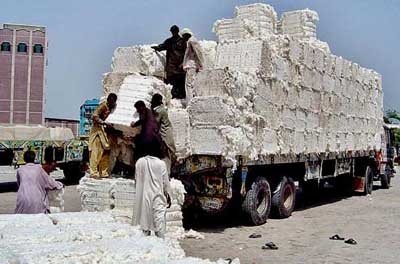
Cotton is a major fiber crop grown in Pakistan. It is mainly grown in Sindh and Punjab provinces where the temperature is high in most of the areas. Cotton is multipurpose crop; and the fiber is the most important product regarding utilization. It is also a big source of many by-products e.g. cotton seed oil contributes about 82 per cent to the total oil production in Pakistan. Cottonseed cake is nutritious feed for milch animals. In cotton seed 20 per cent oil and 25 per cent protein is also present. Dried cotton sticks are the cheap source of fuel for domestic use in rural areas.
In the economy of Pakistan, agriculture adds nearly 21 per cent to national income gross domestic product (GDP). About 62 per cent of the rural population in the country is directly or indirectly associated with this sector and about 42 per cent of countrys work force is engaged with agro-based industries. It is reported that share of cotton to the value addition in agriculture is 8.6 per cent. Pakistan occupies fourth position in production of raw cotton and ranks third in the world on the basis of consumption. In 1947, production of cotton was only 1.23 million bales, whereas of 14.6 million bales were achieved in 2004-05, followed by the production second largest crop of 12,769 millionbales in 2013-14. The average yield of cotton in the country was 773 kg/ha during the year 2013-14 as against Australia (1982 kg/ha), Turkey (1289 kg/ha), Brazil (1124 kg/ha), China (1119 kg/ha) and Greece (1040 kg/ha).
Keeping in view the contribution, the crop is grown extensively in the Punjab province and using cotton production technology the growers are harvesting varying yields. Amongst other components of crop production, availability of water is the major one. It has been observed that cotton does not use water efficiently, hence it is sensitive to drought. Drought is a serious problem that limits cotton production in many regions of the world including Pakistan. The climatic conditions of cotton belt are favourable for growth and development of cotton plant, but there are certain biotic and abiotic stresses which adversely affect crop productivity. Yield is severely affected when drought stress occurs during the reproductive phase.
Cotton plant has adopted semi-arid regions due to extensive root system and flexible fruiting period. Drought affects root distribution seriously, and ultimately yield. The effect of water stress on yield depends on the time at which stress occurs and its intensity. High temperature and shortage of water adversely affect the cultivation of cotton crop. These two abiotic factors are positively correlated with each other i.e. prevalence of drought condition for longer time increases the canopy temperature which adversely affects photosynthesis and transpiration processes. Use of irrigation water is necessary for crop growth under irrigated conditions because different physiological and metabolic functions taking place in plant body are controlled by water contents of plant.
Water is an essential component to maintain cell turgidity, which is related to photosynthesis, growth of cells, tissue and organs. The plant performance is adversely affected by the shortage or excess of water. Shedding off squares and bolls from the plant is caused by drought stress combined with high temperature during growing season of cotton crop. It has been reported that 75 per cent losses occur due to the fall off the fruiting nodes.
Drought is a yield limiting factor, its intensity is important because even moderate water stress decreases growth and yield. The water resources of Pakistan, both surface and sub-surface, are limiting to meet the demand of water for irrigated areas, so there is a need to develop high yielding and better performing drought resistant cotton varieties to overcome this problem. Cotton yield decreases considerably when irrigation is not applied at any critical growth stage. The decrease in seed cotton yield is mainly due to the reduction in number of bolls under water stress.
The yield of seed cotton is reduced due to the water stress during the early fruiting period and the effective fruiting period starts only after mid-August that contributes to the yield. Cotton breeders should start breeding for water stress tolerant cultivars to enhance the yield as yield of cotton is directly correlated with water during the early season of growth.
Water stress in cotton at late bloom stages reduces late developing bolls and fiber strength in mid canopy bolls and increases micronire of existing bolls. Fiber length is mainly affected at 16-20 days after flowering and fiber strength at 25-30 days into boll development through three to four days prior opening.
It is the primary objective of cotton breeder to maximize the yield of seed cotton for this purpose it is necessary to improve cotton plant against the biotic stresses like water stress. For the achievement, cotton plant should be modified with morphological, physiological and biochemical ways. Assessment of genotypic responses to water stress in upland cotton by using data on flowering and fruit setting in water stressed environment is helpful to the breeders for comparing the potential of varieties/lines of cotton to drought tolerance.
The information derived from these studies may be used to develop drought tolerant cotton material that might give economic yield in water stressed conditions of cotton belt.
The authors are associated with the Department of Agronomy University of Agriculture, Faisalabad. They can be reached at <Shakoor2914@gmail.com>